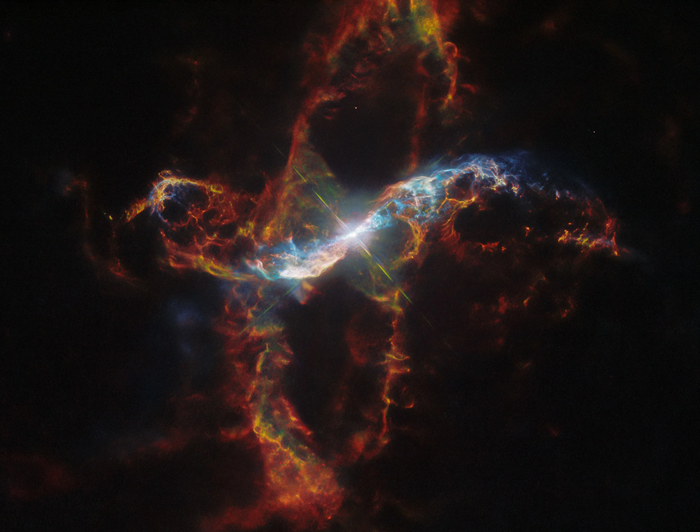NASA's Hubble Space Telescope has captured a striking close-up of one of the galaxy's most energetic stars, creating a vast spiral formation among surrounding stars.

This NASA Hubble Space Telescope image features the binary star system R Aquarii. Image Credit: NASA, ESA, Matthias Stute, Margarita Karovska, Davide De Martin (ESA/Hubble), Mahdi Zamani (ESA/Hubble).
Approximately 700 light-years from Earth, the binary star system R Aquarii experiences violent eruptions that expel massive streams of luminous gas. These swirling stellar emissions resemble a chaotic lawn sprinkler, vividly illustrating how the universe redistributes the nuclear energy generated within stars as it is released into space.
R Aquarii is part of a category of binary stars known as symbiotic stars. The primary component is an aging red giant, while its companion is a dense, burned-out star referred to as a white dwarf. The red giant, classified as a Mira variable, is more than 400 times the size of the Sun. This enormous star undergoes pulsations, temperature fluctuations, and changes in brightness, varying by as much as 750 times over a period of approximately 390 days. At its brightest, it outshines the Sun by nearly 5,000 times.
When the white dwarf approaches the red giant during its 44-year orbital cycle, it gravitationally pulls in hydrogen gas. This gas accumulates on the dwarf star's surface until it ignites in a sudden nuclear fusion event, causing a massive explosion akin to a colossal hydrogen bomb. Following this eruption, the cycle of fuel accumulation starts anew.
The explosion sends geyser-like plasma streams outward, creating unusual loops and trails as it escapes from the core. Twisted by the force of the blast, the plasma is funneled upwards and outwards by intense magnetic fields, resulting in a spiral pattern. This plasma is expelled into space at speeds exceeding 1 million miles per hour, allowing it to travel from Earth to the Moon in just 15 minutes. The filaments glow in visible light due to the intense radiation emitted by the two stars.
Hubble's initial observation of R Aquarii took place in 1990. It identified the star as a binary system consisting of two luminous stars positioned roughly 1.6 billion miles apart. Recently, the ESA/Hubble team created a distinctive time-lapse showcasing R Aquarii's dynamic behavior through observations made from 2014 to 2023.
The five images reveal the swift and striking changes occurring in the binary system and its surrounding nebula. The brightness of the binary stars fluctuates due to intense pulsations from the red giant component.
The magnitude of this phenomenon is remarkable, even by astronomical standards. Material expelled into space can be traced up to 248 billion miles from the binary stars, which is 24 times the diameter of our solar system. Observations like these and others from Hubble are anticipated to transform our understanding of exceptional stellar "volcanoes" like R Aquarii.
For more than 30 years, the Hubble Space Telescope has been utilized to make ground-breaking discoveries that enable us to better understand the universe in which we exist. ESA (European Space Agency) and NASA cooperate internationally on the Hubble project.
NASA's Goddard Space Flight Center in Greenbelt, Maryland, handles the telescope and mission operations. Lockheed Martin Space in Denver, Colorado, also assists with mission operations at Goddard. The Space Telescope Science Institute in Baltimore, Maryland, operated by the Association of Universities for Research in Astronomy, manages NASA's Hubble science operations.
This video features five frames spanning from 2014 to 2023 of R Aquarii. These frames show the brightness of the central binary changing over time due to strong pulsations in the red giant star. The central structures spiral outward due to their interaction with material previously ejected by the binary. This timelapse highlights the value of Hubble's high resolution optical observations in the changing universe, known as time-domain astronomy. Video Credit: NASA, ESA, Matthias Stute, Margarita Karovska, Davide De Martin, Mahdi Zamani, N. Bartmann (ESA/Hubble)